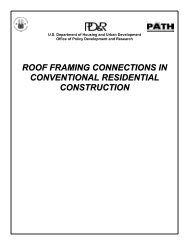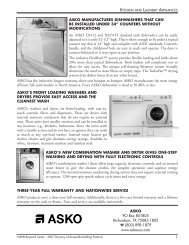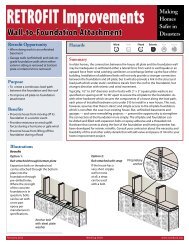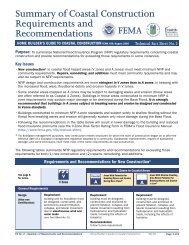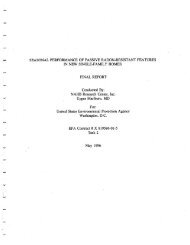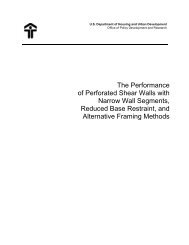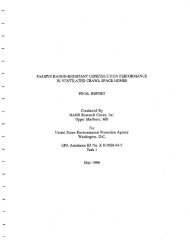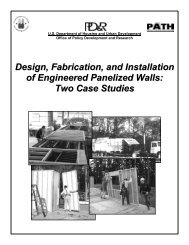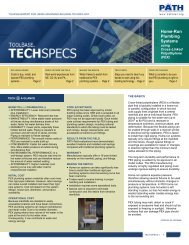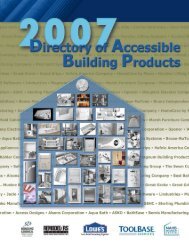The Rehab Guide, Volume 2: Exterior Walls - ToolBase Services
The Rehab Guide, Volume 2: Exterior Walls - ToolBase Services
The Rehab Guide, Volume 2: Exterior Walls - ToolBase Services
You also want an ePaper? Increase the reach of your titles
YUMPU automatically turns print PDFs into web optimized ePapers that Google loves.
In addition to their primary functions as air infiltration barriers and water vapor transmitters,some (but not all) of the major housewrap brands are code approved as substitutes for required moistureprotection barriers. To gain national code approval as a substitute for No. 15 felt, the product manufacturermust apply to each of the three major model building codes, or CABO, and supply specific testingdata on water penetration resistance. With code recognition, the product can be used under all sidingapplications, including stucco and masonry veneer. Currently, at least four products are listed by all threemodel codes as acceptable moisture protection barriers: Amowrap, Pinkwrap, R-Wrap, and Tyvek. Tyvekalso produces a product, StuccoWrap, that is specifically intended for use with traditional and syntheticstucco, and is code listed for that application. Other housewraps are acceptable to some codes as weatherresistant barriers. Before using a particular product as a weather barrier, its approval should be verifiedwith the governing code.In addition to air leakage resistance, permeance, and moisture resistance, two other materialcharacteristics are worth considering: UV sunlight resistance, and strength. All major housewrap brandshave a manufacturer’s rated UV exposure time ranging from 120 days to more than 1 year. Some productsare manufactured with antioxidants and UV stabilizers, while others are naturally more resistant by theircomposition. In the field, however, covering the housewrap as quickly as practicable is recommended, assome UV degradation will occur even over a short period, and other unrelated damage to the membranecan be avoided.Strength of the housewrap can be critical, as wind conditions or adverse job site handling cantear or puncture the material during and after installation. Even small holes can negatively affect overallperformance. <strong>The</strong> inherent strengths of housewrap can be judged on three levels: tensile strength, tearstrength, and burst strength. Respectively, these are the material’s ability to withstand damage from pullingand stretching; withstand tearing at nail and staple locations; and to withstand separation of materialfibers, fabrics, or films. Unfortunately, testing procedures and standards vary between manufacturers, soproduct comparison is difficult. Generally, the spun bonded products have good tensile and burst strengthbut tear easily; woven and fiber-reinforced have good tear and burst strength, but are susceptible to diagonaltensile loading; laminated film products tend to be weakest of all and can lose strength significantly,making a tight installation more difficult.Although the wide variety of housewrap products with varying performance characteristics mayappear confusing, they offer a wide selection for any particular job. In northern heating climates, whereinterior vapor barriers are the norm, a highly moisture vapor permeable housewrap may be required. Inhot, humid, cooling climates, where an interior vapor barrier is not required, a housewrap with a low airleakage rate may be preferred. In low-wind environments, a low-strength material may be selected. A particularlycost-conscious choice would be laminated film.TECHNIQUES, MATERIALS, TOOLSINSTALL HOUSEWRAP OVER NEW OR EXISTING SHEATHING.For rehab applications, housewraps will generally be placed over existing solid board sheathing, plywood,or OSB, or over new plywood or OSB where the existing sheathing needs replacement. Housewraps come inrolls of varying widths, with 9 feet being the standard. Other widths are available, depending on the manufacturer,including 1 foot 6 inches, 3 feet, and 4 feet 6 inches. Roll lengths vary from 60 to 200 feet. Somecustom sizes and lengths are available. Material thickness varies somewhat, but is irrelevant in terms of application.Beginning at an outside corner, hold the roll of housewrap vertically and unroll the material acrossthe face of the sheathing for a short distance. Make sure the roll remains plumb and that the bottom edge ofthe housewrap extends over the foundation by two inches. <strong>The</strong> application should start at an outside cornerextending around the starting point corner by six inches (Fig. 2).Manufacturers specify acceptable fasteners, typically large head nails, nails with plastic washers, orlarge crown staples. Fastener edge and field spacing patterns are also specified. Housewrap sheets areinstalled shingle-style, from the bottom up. Horizontal laps should be a minimum of 2 inches; vertical lapsof 6 inches are acceptable (Fig. 3). To be fully effective in their primary role as air infiltration barriers, all36



